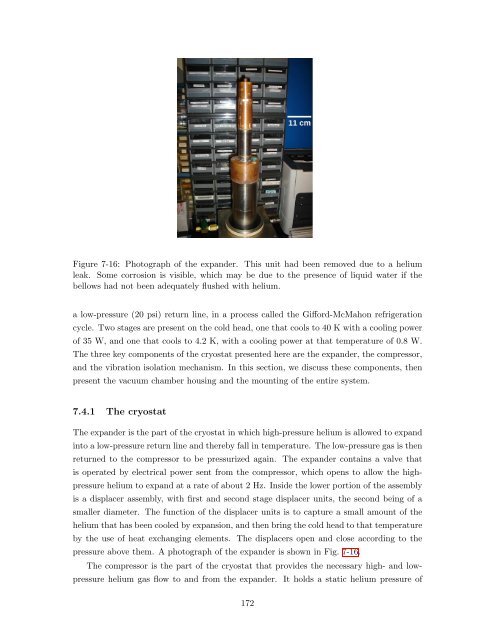Ph.D. Thesis - Physics
Ph.D. Thesis - Physics
Ph.D. Thesis - Physics
Create successful ePaper yourself
Turn your PDF publications into a flip-book with our unique Google optimized e-Paper software.
Figure 7-16: <strong>Ph</strong>otograph of the expander. This unit had been removed due to a helium<br />
leak. Some corrosion is visible, which may be due to the presence of liquid water if the<br />
bellows had not been adequately flushed with helium.<br />
a low-pressure (20 psi) return line, in a process called the Gifford-McMahon refrigeration<br />
cycle. Two stages are present on the cold head, one that cools to 40 K with a cooling power<br />
of 35 W, and one that cools to 4.2 K, with a cooling power at that temperature of 0.8 W.<br />
The three key components of the cryostat presented here are the expander, the compressor,<br />
and the vibration isolation mechanism. In this section, we discuss these components, then<br />
present the vacuum chamber housing and the mounting of the entire system.<br />
7.4.1 The cryostat<br />
The expander is the part of the cryostat in which high-pressure helium is allowed to expand<br />
into a low-pressure return line and thereby fall in temperature. The low-pressure gas is then<br />
returned to the compressor to be pressurized again. The expander contains a valve that<br />
is operated by electrical power sent from the compressor, which opens to allow the high-<br />
pressure helium to expand at a rate of about 2 Hz. Inside the lower portion of the assembly<br />
is a displacer assembly, with first and second stage displacer units, the second being of a<br />
smaller diameter. The function of the displacer units is to capture a small amount of the<br />
helium that has been cooled by expansion, and then bring the cold head to that temperature<br />
by the use of heat exchanging elements. The displacers open and close according to the<br />
pressure above them. A photograph of the expander is shown in Fig. 7-16.<br />
The compressor is the part of the cryostat that provides the necessary high- and low-<br />
pressure helium gas flow to and from the expander. It holds a static helium pressure of<br />
172
















